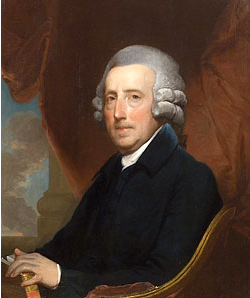Thomas Dawes


Thomas Dawes (August 5, 1731 – January 2, 1809) was a patriot who served as a Massachusetts militia colonel during the American Revolution and afterward assumed prominent positions in Massachusetts's government.[1][2] His positions included membership and chairmanship of the Massachusetts Governor's Council and representative in both the House and Senate. As chairman of the Governor's Council, Dawes served briefly as the de jure presiding officer of the executive branch of Massachusetts' state government for ten days – May 20, 1800 to May 30, 1800 – following the death of first Governor Increase Sumner and then Lieutenant Governor Moses Gill. (See List of governors of Massachusetts.)[3]

Dawes was born in Boston. Prior to the Revolution, he attended a regular school and worked as a mechanic. He ardently supported the Whigs, gaining infamy among Royalists; his house was plundered by the British when they withdrew from Boston in 1776. Later, he became active in politics, lived in a roomy house on Purchase Street beside John Adams, and worked as an architect and builder designing many notable buildings in Boston, including the Brattle Street Church and repairs and/or modifications on the Old State House in about 1772.[4][5][6]

He was the master builder for Hollis Hall at Harvard College and probably also designed the building. Only 11 days after the construction of Hollis Hall, a fire destroyed Old Harvard Hall, and in 1766, Thomas Dawes was again chosen as master builder, to replace this building. Three decades later Harvard again called upon him, this time to build Stoughton Hall. He helped build the Shirley-Eustis House for Governor William Shirley.[8][9][10] He was elected a Fellow of the American Academy of Arts and Sciences in 1784.[11] He attended Old South Church from 1786 until his death in 1809, and was a good friend of John Hancock.
Dawes, a member of the prominent Dawes family of Massachusetts Bay, was a cousin of the April 1775 Whig patriot William Dawes. He married Hannah Blake on July 1, 1752. Their son Thomas Dawes (July 8, 1757 – July 21, 1825) was a jurist and an alumnus of Harvard University, graduating in 1777, served in the Massachusetts ratifying convention for the United States Constitution in 1787-1788, and served in the Massachusetts Supreme Judicial Court from 1792 to 1802; he married Margaret Greenleaf.[12] Through his son Thomas, Thomas Dawes was the 3rd great grandfather of the poet T.S. Eliot.[13]
-
Hollis Hall, Harvard University
-
Harvard Hall, Harvard University
-
Stoughton Hall
References
[edit]- ^ Dawes, Thomas. An Oration Delivered March 5, 1781 at the Request of the Inhabitants of the Town of Boston, to Commemorate the Bloody Tragedy of the Fifth of March 1770, printed by Thomas and John Fleet, Boston, 1781.
- ^ Dawes, Thomas. An Oration, Delivered July 4, 1787, at the Request of the Inhabitants of the Town of Boston, in Celebration of the Anniversary of American Independence, printed by Samuel Hall, Boston, 1787.
- ^ Eckley, Joseph. "Obituary: Sketch of the Character of the Late Hon. Thomas Dawes, Esq.", 1809, Boston Athenaeum Library, Tracts B438, B1213.
- ^ Holland, Henry W. William Dawes and his Ride with Paul Revere, p. 60, John Wilson & Son, Boston, Massachusetts, 1878.
- ^ Dawes, C. Burr. William Dawes: First Rider for Revolution, pp. 60, 70, Historic Gardens Press, Dawes Arboretum, Newark, Ohio, 1976.
- ^ Moore, George Henry. Prytaneum Bostoniense: Notes on the History of the Old State House, pp. 27–28, Upham & Co., Boston, Massachusetts, 1885.
- ^ Cummings, Abbott Lowell. "A Recently Discovered Engraving of the Old State House in Boston", Colonial Society of Massachusetts, 2017. (https://www.colonialsociety.org/node/774) Retrieved August 2018.
- ^ Detwiller, Frederick C. "Thomas Dawes: Boston's Patriot Architect", Old-Time New England, Bulletin of the Society for the Preservation of New England Antiquities, vol. 67, nos. 1–2, Summer–Fall 1977, Serial Nos. 249-250, pp. 1-5. (https://hne-rs.s3.amazonaws.com/filestore/1/2/8/6/4_aa15642d7f7510e/12864_55501fa2fb2014a.pdf) Retrieved August 2018.
- ^ Holland, Henry W. William Dawes and his Ride with Paul Revere, p. 60, John Wilson & Son, Boston, Massachusetts, 1878.
- ^ Dawes, C. Burr. William Dawes: First Rider for Revolution, pp. 53, 60, Historic Gardens Press, Dawes Arboretum, Newark, Ohio, 1976.
- ^ "Book of Members, 1780–2010: Chapter D" (PDF). American Academy of Arts and Sciences. Retrieved July 28, 2014.
- ^ Maier, Pauline. Ratification: The People Debate the Constitution, 1787–1788, pp. 171–2, 176, 178, 186, 201, Simon & Schuster, New York, New York, 2010. ISBN 978-0-684-86854-7.
- ^ "Family relationship of Thomas Dawes and T. S. Eliot via Thomas Dawes". famouskin.com. Retrieved 2025-01-14.
Further reading
[edit]- Frederic C. Detwiller. Thomas Dawes: Boston's patriot architect[permanent dead link]. Old-Time New England, 1977.
- Architects from Boston
- Members of the Massachusetts Governor's Council
- Massachusetts militiamen in the American Revolution
- Justices of the Massachusetts Supreme Judicial Court
- 1731 births
- 1809 deaths
- Fellows of the American Academy of Arts and Sciences
- 18th-century American people
- Lawyers from Boston
- Harvard University alumni
- People from colonial Massachusetts
- Patriots in the American Revolution



